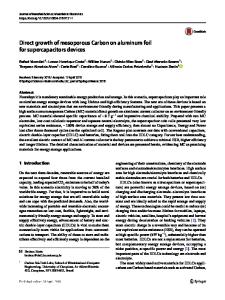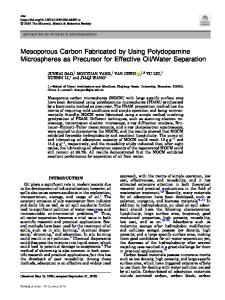Monomer self-deposition synthesis of N-doped mesoporous carbon tubes using halloysite as template for supercapacitors
- PDF / 2,535,227 Bytes
- 13 Pages / 595.276 x 790.866 pts Page_size
- 54 Downloads / 326 Views
Monomer self-deposition synthesis of N-doped mesoporous carbon tubes using halloysite as template for supercapacitors Beibei Liu1, Lei Wang1, Yue Zhang1, Juan Du1,*, and Aibing Chen1,2,* 1 2
College of Chemical and Pharmaceutical Engineering, Hebei University of Science and Technology, Shijiazhuang 050018, China CAS Key Laboratory of Carbon Materials, Institute of Coal Chemistry, Chinese Academy of Sciences, Taiyuan 030001, China
Received: 22 June 2020
ABSTRACT
Accepted: 3 October 2020
N-doped mesoporous carbon tubes (NMCT) can be widely used as electrode materials in supercapacitors with high performance due to their length-diameter ration, low tortuosity, openness, high specific surface area, large pore volume and electrical conductivity. Herein, a universal monomer self-deposition method is developed to prepare NMCT, which was the self-deposition of 3-aminophenol (3-AP) on natural halloysite nanotubes (HNTs) acted as template assisted by strong adsorption effect due to HNTs porous structure and catalytic action of surface acidity of the HNTs. The as-prepared NMCT possessed completely reproduced the morphology of HNTs, showing hollow tubular structure, thin shell, large specific surface area of 1071 m2 g-1, uniform mesoporous distribution and high nitrogen content of 4.04 at%. The pyrolysis temperature and mass ratio of 3-AP to HNTs show strongly influence on the specific surface area and pore volume of as-prepared NMCT, leading to the discrepancy in electrochemical performances for supercapacitor. Under optimal conditions, benefiting from the distinctive structural feature and desirable N doping, the NMCT exhibits a high specific capacitance of 269 F g-1 at 0.5 A g-1 and an excellent rate capacitance retention of 92.3% after 10,000 stability cycles, demonstrating its great potential in the application of supercapacitors.
Ó
Springer Science+Business
Media, LLC, part of Springer Nature 2020
Introduction Due to the environmental and energy crisis, the development of sustainable safe energy storage devices is of utmost importance to meet the demand
of smart power grids, intermittent renewable energy sources and electrical vehicles [1]. As one of the important energy storage devices, supercapacitors can operate at a much higher power density than batteries and possess greater energy density than
Handling Editor: Christopher Blanford.
Address correspondence to E-mail: [email protected]; [email protected]
https://doi.org/10.1007/s10853-020-05414-8
J Mater Sci
conventional dielectric capacitors, becoming a hot research topic in the field of electrical energy storage [2]. Although major progress has been made in improving energy storage for supercapacitors in the past decade, the electrode materials of the supercapacitor is still one of the most important factors affecting its performance and large-scale practical applications [3]. In recent years, carbon materials, including various morphologies, such as spheres, sheets, tubes, fibers and monolith, have gained considerable attention and are promisin
Data Loading...











